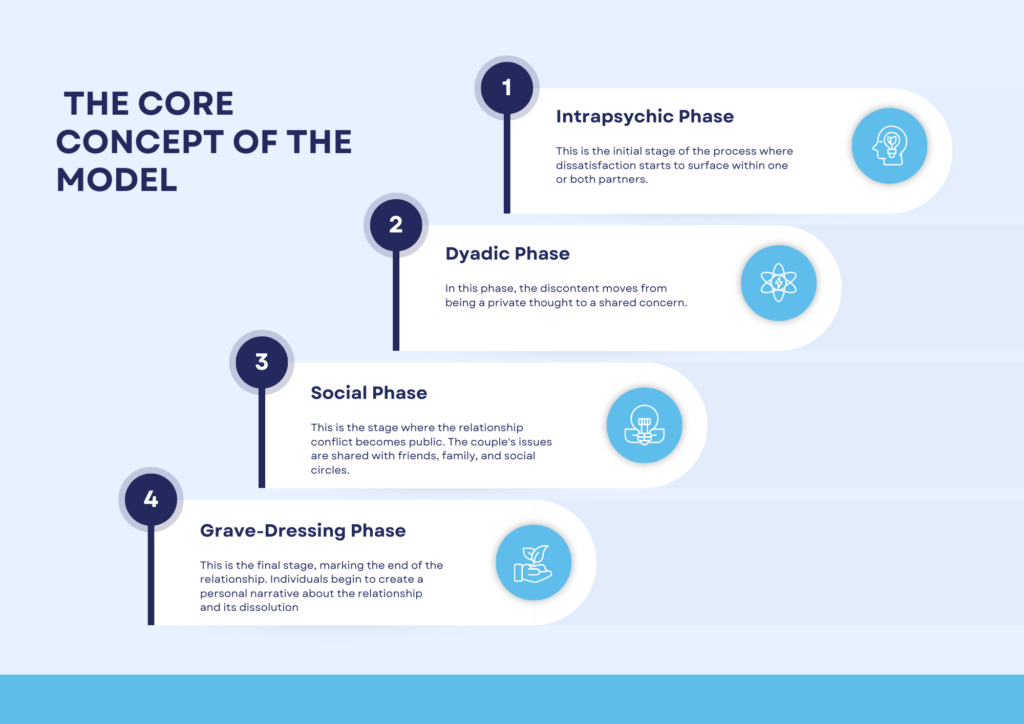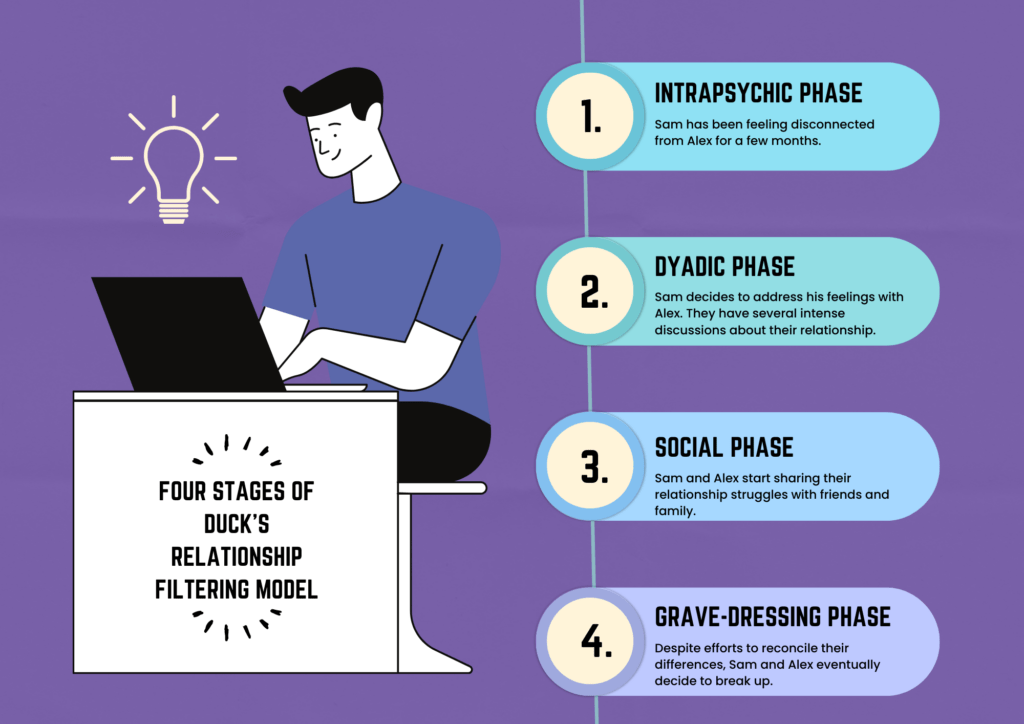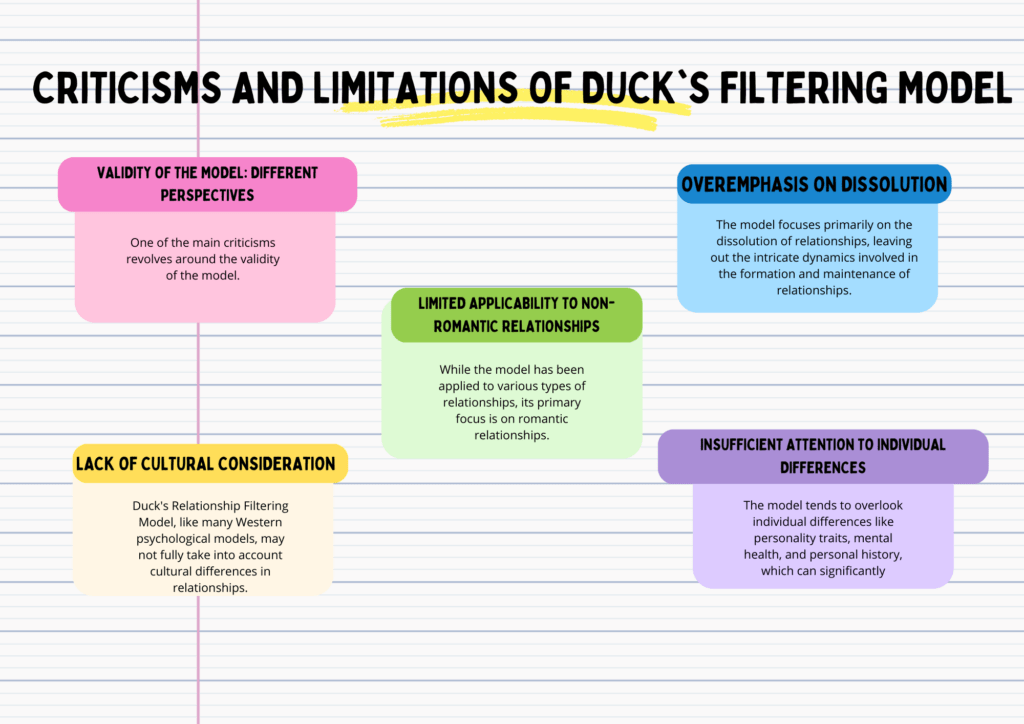Brief Overview of Duck’s Relationship Filtering Model
The Duck’s Relationship Filtering Model, proposed by Steve Duck, is a comprehensive framework designed to elucidate the intricate process of relationship formation and dissolution. This model explores the progression and often regression of relationships, providing a step-by-step guide to the complexities involved.
At its core, the model outlines four stages that relationships generally go through, namely: the intrapsychic phase, dyadic phase, social phase, and grave-dressing phase. Each of these stages signifies a unique period in the relationship, characterized by different interactions, emotions, and external influences.
In essence, the Duck’s Relationship Filtering Model serves as a mirror reflecting the nuanced dynamics of relationships. It aids individuals in understanding their relational patterns, guiding them toward more fulfilling and meaningful connections.
Brief History
The Duck’s Relationship Filtering Model has its roots in the scholarly work of Steve Duck, a British social psychologist who has dedicated his career to the study of interpersonal communication and relationships. A notable figure in his field, Duck has authored and co-authored numerous influential books and papers on relationships, conversation, and communication theory.
The model emerged during the late 20th century, a time when research in interpersonal relationships was gaining traction within social psychology. Recognizing a gap in understanding how relationships dissolve, Duck aimed to create a comprehensive model that could explain this process in detail. His goal was to move beyond simple explanations and delve into the intricacies of how and why relationships end.
Duck’s Relationship Filtering Model is largely based on theories of social interaction and draws inspiration from various fields of study including psychology, sociology, and communication. For example, the idea of the ‘intrapsychic phase’ is reminiscent of cognitive dissonance theory, with individuals wrestling with conflicting thoughts and feelings. The ‘social phase’, on the other hand, aligns with sociological perspectives on the influence of societal norms and peer groups on individual behavior.
Over time, the model has been revised and refined to account for a broader range of relationships and societal changes. Its practical applicability, coupled with its intuitive structure, has earned it widespread recognition and adoption in both academic and non-academic settings.
To this day, Duck’s Relationship Filtering Model remains an essential tool for understanding the nuanced stages of relationship development and dissolution. It continues to inspire researchers and practitioners alike, paving the way for new insights in the field of interpersonal communication and relationships.
Importance of Understanding Relationship Dynamics
Understanding relationship dynamics is crucial for a number of reasons, not least of which is the central role relationships play in our lives. From familial bonds and friendships to romantic partnerships and professional alliances, relationships are the foundation upon which we build our social worlds.
Firstly, a sound grasp of relationship dynamics allows for better self-awareness. By understanding our patterns of interaction, emotional responses, and conflict-resolution strategies, we can identify areas of growth and work towards becoming better communicators and partners.
Secondly, understanding relationship dynamics fosters empathy and improves our capacity to navigate diverse social interactions. This comprehension enables us to appreciate the perspectives of others and respond effectively in a variety of interpersonal situations, promoting harmony and reducing conflict.
Furthermore, in the context of romantic relationships, understanding these dynamics can help prevent harmful patterns from forming or persisting. This knowledge can facilitate healthier, more satisfying relationships by encouraging constructive communication, promoting emotional intelligence, and providing tools to handle relationship stressors.
In the professional realm, grasping these dynamics can enhance teamwork, foster a positive work environment, and facilitate effective leadership. It can improve negotiation skills, enable better conflict management, and foster stronger professional relationships, all of which contribute to successful workplace outcomes.
In essence, understanding relationship dynamics is an essential life skill, offering valuable insights that can improve our interactions on both personal and professional fronts. It paves the way towards healthier, more rewarding relationships and overall social well-being.
The Core Concept of the Model
Four Stages of Duck’s Relationship Filtering Model
The Duck’s Relationship Filtering Model categorizes the progression and dissolution of relationships into four distinct stages. Each stage marks a different phase in the relationship journey, signifying specific internal and external dynamics. Here’s a brief overview:

A. Intrapsychic Phase: This is the initial stage of the process where dissatisfaction starts to surface within one or both partners. It’s characterized by introspection and internal dialogue, where individuals begin to assess their dissatisfaction, contemplate the problems in the relationship, and weigh their options.
B. Dyadic Phase: In this phase, the discontent moves from being a private thought to a shared concern. The partners start to openly discuss the issues in their relationship, engaging in dialogue about their feelings, future plans, and potential solutions or ending the relationship.
C. Social Phase: This is the stage where the relationship conflict becomes public. The couple’s issues are shared with friends, family, and social circles. This external involvement often impacts the direction of the relationship, with societal pressure either facilitating a resolution or pushing towards the relationship’s end.
D. Grave-Dressing Phase: This is the final stage, marking the end of the relationship. Individuals begin to create a personal narrative about the relationship and its dissolution, often ‘dressing’ the relationship in a way that allows them to move on. It’s a stage of emotional processing, acceptance, and narrative creation.
The Four Stages of Duck’s Relationship Filtering Model: Explained with Examples: Story of Sam and Alex
let’s use the example of a hypothetical couple, Sam and Alex, to illustrate the four stages of Duck’s Relationship Filtering Model.

A. Intrapsychic Phase: Sam has been feeling disconnected from Alex for a few months. He finds himself frequently thinking about their lack of shared interests and the growing distance between them. This internal dialogue makes Sam increasingly aware of his dissatisfaction with the relationship.
B. Dyadic Phase: Sam decides to address his feelings with Alex. They have several intense discussions about their relationship. Alex expresses surprise but also admits that she, too, has felt a change. They talk about their problems, including their diverging interests and lack of quality time spent together.
C. Social Phase: Sam and Alex start sharing their relationship struggle with friends and family. They receive various pieces of advice, some suggesting ways to mend the relationship, others opined that perhaps it’s best to part ways. The public nature of their troubles adds an additional layer of complexity to their decision-making process.
D. Grave-Dressing Phase: Despite efforts to reconcile their differences, Sam and Alex eventually decide to break up. They each begin to craft their own narratives about the relationship and its end – why it didn’t work out, what they learned, and how they can move forward. These narratives help them to emotionally process the breakup and ultimately find closure.
In this example, each stage of Duck’s Relationship Filtering Model is clearly identifiable, demonstrating the path from the onset of dissatisfaction to the eventual dissolution of a relationship. Each phase brings its own unique set of challenges and emotional processes.
Impact of Duck’s Relationship Filtering Model on Interpersonal Communication
Understanding Individual Behavior in Relationships
Duck’s Relationship Filtering Model provides a theoretical lens to view and interpret individual behaviors in relationships. By identifying the different stages of relationship dissolution, the model helps us understand why people behave the way they do during various phases of a relationship.
For instance, during the intrapsychic phase, a person might appear distant or disconnected as they internally process their feelings of dissatisfaction. In the dyadic phase, heated discussions or emotional confrontations may occur as issues are brought to the surface. Understanding these behaviors can help individuals and couples better navigate their relationships, addressing concerns proactively and fostering understanding.
Moreover, the model can also aid in identifying patterns of behavior that contribute to relationship issues, empowering individuals to make positive changes. This heightened understanding of one’s own and others’ behavior can lead to improved relationship satisfaction and interpersonal harmony.
Enhancing Communication Effectiveness
Effective communication is a cornerstone of healthy relationships, and Duck’s model directly influences our understanding of this aspect. By outlining the progressive stages of relationship dissolution, the model highlights the importance of communication at each phase.
For example, in the dyadic phase, open, honest, and empathetic communication can prevent misunderstandings and aid in conflict resolution. In the social phase, thoughtful dialogue with friends and family can help individuals gain perspective and make informed decisions.
Furthermore, the model encourages introspective communication – self-talk that helps individuals understand their emotions and needs better. This aspect of internal communication is crucial in the intrapsychic and grave-dressing phases, promoting emotional well-being and closure.
Overall, Duck’s Relationship Filtering Model underlines the central role of communication in managing relationships. By improving our understanding of relationship dynamics, it equips us with the tools to communicate more effectively, enhancing both our personal and social interactions.
Practical Applications of the Model
The Duck’s Relationship Filtering Model holds significant value not just theoretically but also in a practical context. Its comprehensive framework provides actionable insights to navigate various types of interpersonal relationships. Here are some examples:
Using the Model to Strengthen Relationships
By identifying potential issues early, such as during the intrapsychic phase, individuals can proactively address concerns before they escalate. This could involve seeking professional help, such as counselling, or initiating honest discussions with their partners to find common ground and solutions.
The model can also assist in understanding how external influences, considered during the social phase, can impact a relationship. This knowledge can help individuals manage these influences better and protect the relationship from unnecessary strain.
Applying the Model to Resolve Relationship Conflict
Understanding the stages of relationship dissolution can help individuals and couples identify where they are in the process and guide their actions accordingly. For example, recognizing that they are in the dyadic phase might encourage more open discussions and negotiation.
During the social phase, individuals might lean on their support systems more effectively, seeking advice or sharing their feelings. This stage can also serve as a reminder that external influences should not dictate the course of a relationship.
The grave-dressing phase offers valuable insights for individuals going through a breakup. It emphasizes the importance of crafting a personal narrative and finding closure, guiding individuals toward healing and growth.
Using the Model in Therapy and Counseling
For professionals in fields such as psychology, counseling, and social work, Duck’s model serves as an effective tool to understand their clients’ relationship issues. It can guide therapeutic interventions and strategies, helping individuals and couples navigate their relational challenges more effectively.
Overall, the practical applications of Duck’s Relationship Filtering Model are far-reaching, aiding in relationship enhancement, conflict resolution, and therapeutic processes. Its comprehensive framework promotes a deeper understanding of relationship dynamics, encouraging more effective management of interpersonal relationships.
Criticisms and Limitations of Duck’s Filtering Model
Like any theoretical model, Duck’s Relationship Filtering Model has its share of criticisms and limitations. While it offers a comprehensive framework for understanding relationship dissolution, there are certain aspects that it may not fully address or capture.

Validity of the Model: Different Perspectives
One of the main criticisms revolves around the validity of the model. The framework proposes a linear progression through its four stages, but real-life relationships may not follow such a neat sequence. Individuals and relationships are complex, and the progression of a relationship’s end could be more chaotic, skipping stages or moving back and forth between them.
Overemphasis on Dissolution
The model focuses primarily on the dissolution of relationships, leaving out the intricate dynamics involved in the formation and maintenance of relationships. While it effectively maps out how relationships end, critics argue that it could provide a more balanced view by addressing relationship formation and maintenance as well.
Lack of Cultural Consideration
Duck’s Relationship Filtering Model, like many Western psychological models, may not fully take into account cultural differences in relationships. Different cultures have diverse values and norms regarding relationships, which may influence how individuals experience and navigate relationship dissolution.
Insufficient Attention to Individual Differences
The model tends to overlook individual differences like personality traits, mental health, and personal history, which can significantly impact how individuals experience each stage of the model. Critics argue that these factors should be considered for a more comprehensive understanding of relationship dynamics.
Limited Applicability to Non-romantic Relationships
While the model has been applied to various types of relationships, its primary focus is on romantic relationships. The dynamics of other types of relationships, such as friendships, family relationships, or professional relationships, might not align perfectly with the stages outlined in the model.
Despite these criticisms and limitations, Duck’s Relationship Filtering Model remains a valuable tool in understanding relationship dissolution. It provides a framework that, when applied with consideration of its limitations, can yield significant insights into the dynamics of ending relationships.
Conclusion
Despite some criticisms and limitations, the model’s comprehensive approach to analyzing relationship dissolution offers a valuable perspective on relationship dynamics. It not only aids in understanding the complexities of ending relationships but also encourages introspection and communication, fostering emotional intelligence.
Moreover, it has significant practical applications, providing insights that can guide individuals and professionals in fields such as counseling and social work. It enhances our ability to navigate interpersonal relationships and contributes to the broader understanding of human social behavior.
In conclusion, Duck’s Relationship Filtering Model plays a critical role in our comprehension of relationships. It continues to be a relevant tool in the field of interpersonal communication, offering both academic and practical value in its application. While there’s always room for refinement, the model’s contribution to understanding relationship dynamics is undeniable.

